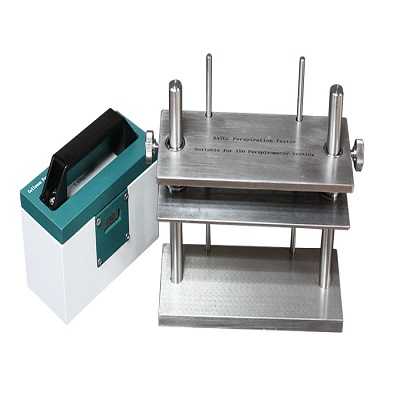Site: Home > News and events 
Measurement Of color Fastness To Perspiration
Perspiration fastness refers to the ability not to fade and not to stain when dyed fabric is perspired. People’s sweat consists of complicate composition, and its main composition is salt. Sweat is divided into acidity and basicity due to difference of people. Textiles contact long with sweat has a large impact on some dyes.
This test is used to determine the fastness of colored textiles to the effects of acid perspiration (sweat). Britishmethods also call for tests to alkaline perspiration. Our lab contains reagents to simulate either type of perspiration.
How Perspiration fastness Test Works:
A colored textile specimen is wet out using a simulated acid perspiration solution. It is placed in contact with a multi-fiber strip, and then both subjected to a fixed mechanical pressure. The specimen is then evaluated for color change using the AATCC Gray Scale for Staining, and the multi-fiber test strip is evaluated for color transfer using the AATCC Chromatic Transference Scale.
Preparation of Test Specimens:
If the textile to be tested in the form of fabric, place a specimen 10 x 4 cm in size between two 10x 4 cm pieces of the two kinds of adjacent fabrics and sew along one of the shorter sides to form a composite specimen. Two such composite specimens are required.
How to do Fastness To Perspiration test
First,Wet one of the composite specimen thoroughly in the alkaline solution using a liquor to specimen ratio of 50:1 and allow it to remain in the solution at room temperature for 30 minutes. press and move it from time to time to ensure good and uniform penetration of the liquor.Pour off the liquor and wipe the excess liquor of the specimen between two glass rods.
Second,Then place the composite specimen between two glass or acrylic resin plates under a force of 5.1 kgs (as the specimen is 10 x 4 cm in size ) in a per spirometer. Keep the per spirometer in the air oven at 37 + /- 2°C for hours.
Third,Open out the composite specimen by breaking the stitches on all the sides except one of the shorter sides.Dry the three parts in air at temperature not more than 60°C.
Forth,With the three parts in contact only at the remaining line of stitching.
Fifth.Treat the second composite in acid solution as noted above instead of an alkaline solution. Evaluate the change in color of the treated test specimens and the degree of staining of the two pieces of adjacent fabric with help of the gray scale and assign the ratings, taking care to first cool the test specimens and the adjacent fabrics to room temperature. In the case of doubt in the rating given by an observer, the accesses menu should be done by at least three observers and the overall average rating should be reported.
Perspiration fastness Testing / Evaluation:
1)Heat loaded specimen unit in oven at 100°±2°F for 6hr.±5min.
2)Remove from oven. Separate multi-fiber strip from fabric. Place in conditioned atmosphere
overnight.
3)For specimen, use AATCC gray scale for color change to evaluate results.
4)For multi-fiber strip, use AATCC chromatic transference scale.
Perspiration fastness Test Report:
1). State that the specimens were tested as directed in Test Method 15 - 2002. Describe the material or product sampled, and the method of sampling used. Also state the solution to which the sample has been exposed.
2). Report the color change grade in the sample fabric, and the staining grades for each fiber type in the multi-fiber test strip. (Make sure to state which scale was used for each evaluation.)
How to Improve the Perspiration Fastness?
In daily life, fabrics will always appear different degrees of discoloration and stain under the influence of sweat stains, so how to improve the perspiration fastness of textiles? It is found that select the dyes reasonably, especially the dyes with high fixation rate and good stability, besides, control the dyeing process and strengthen the conditions of fixation reasonably, so that the dyes can be fully fixed. For example, in the dyeing of less reactive dyes, select the catalyst or the appropriate fixing agent, or fix the color at a higher temperature.
2019-07-31 15:17
- Related News
What's the difference between a hydraulic oil filter and a regular oil filter?
Interpretation of Paper Tear Strength Standards
What is the significance of the LA abrasion test?
What is a UTM machine used for?
What is the principle of a capillary rheometer?
What is the difference between conical and parallel twin-screw extruders?
What is the ISO standard for color fastness?
What is the use of a roundness tester?
The Role of Dust-Proof Robot Protective Clothing
What is the difference between Taber and Martindale abrasion tests?

